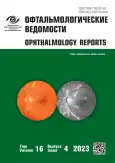Development of schematic representations for globe removal and formation of the supporting-motor stump for use in ophthalmological and radiological practice
- Authors: Davydov D.V.1, Gridasova I.S.2, Serova N.S.2, Pavlova O.Y.2, Konovalov K.A.3
-
Affiliations:
- P.A. Herzen Moscow Oncology Research Institute, branch of the National Medical Research Center of Radiology
- I.M. Sechenov First Moscow State Medical University (Sechenov University)
- 1586 Military Clinical Hospital
- Issue: Vol 16, No 4 (2023)
- Pages: 43-53
- Section: Original study articles
- URL: https://journals.rcsi.science/ov/article/view/254572
- DOI: https://doi.org/10.17816/OV623658
- ID: 254572
Cite item
Abstract
BACKGROUND: Today, the issue of globe endoprosthetics is an extremely important problem due to several reasons: the presence of various methods for globe removal, the variety of implants and surgical installation techniques, non-standard cavities before prosthetics, the lack of a unified algorithm for examining the patients at the pre- and postoperative stages, as well as difficulties in the rehabilitation of patients with anophthalmos and high aesthetics requirements.
AIM: Development of schematic images of performing various surgical techniques for globe removal and forming a supporting-motor stump for a cosmetic prosthesis.
MATERIALS AND METHODS: During 2020–2023, in different institutions, 43 patients (100%) were examined for globe endoprosthetics, from 18 to 65 years old, 23 men, 20 women. The authors analyzed CT data obtained at the radiological department No. 2 of Sechenov University and at the 1586 Military Clinical Hospital of the Russian Ministry of Defense.
RESULTS: All patients (n = 43; 100%) underwent a globe removal in various modifications depending on the initial condition, in 39 cases (78%) — reconstructive surgery for the endoprosthesis installation in order to form a volumetric supporting-motor stump, and further external cosmetic prosthetics. In 10 patients (22%), the endoprosthesis was installed after enucleation of the globe, in 33 (78%) — after evisceration in various modifications.
CONCLUSIONS: This paper presents schematic images of various techniques for surgical globe removal, formation of a supporting-motor stump, types of endoprostheses, the options of external cosmetic prosthetics and the presence of complications, as well as a CT protocol for the description of obtained images.
Full Text
##article.viewOnOriginalSite##About the authors
Dmitry V. Davydov
P.A. Herzen Moscow Oncology Research Institute, branch of the National Medical Research Center of Radiology
Email: d-davydov3@yandex.ru
ORCID iD: 0000-0002-8025-4830
SPIN-code: 1368-2453
MD, Dr. Sci. (Medicine), Professor
Russian Federation, MoscowIrina S. Gridasova
I.M. Sechenov First Moscow State Medical University (Sechenov University)
Email: dr.gridasova_irina@mail.ru
ORCID iD: 0009-0001-4851-3054
Russian Federation, Moscow
Nataliya S. Serova
I.M. Sechenov First Moscow State Medical University (Sechenov University)
Email: dr.serova@yandex.ru
ORCID iD: 0000-0003-2975-4431
SPIN-code: 4632-3235
Dr. Sci. (Medicine), Professor, Corresponding Member of the Russian Academy of Sciences
Russian Federation, MoscowOlga Yu. Pavlova
I.M. Sechenov First Moscow State Medical University (Sechenov University)
Email: pavlova_o_yu@staff.sechenov.ru
ORCID iD: 0000-0001-8898-3125
SPIN-code: 8326-0220
MD, Cand. Sci. (Medicine)
Russian Federation, 8/2 Trubetskaya st., Voscow, 119048Konstantin A. Konovalov
1586 Military Clinical Hospital
Author for correspondence.
Email: kkonovalov82@mail.ru
ORCID iD: 0000-0002-6880-0077
SPIN-code: 3604-0676
MD, Cand. Sci. (Medicine)
Russian Federation, MoscowReferences
- Gushchina MB, Yuzhakova NS, Gavrilova NA, Kondratenko TS. Eye removal surgical techniques. Russian Journal of Clinical Ophthalmology. 2020;20(1):37–48. doi: 10.32364/2311-7729-2020-20-1-37-48
- Luzyanina VV. Ophthalmoplasty in ocular prosthetics. Pacific Medical Journal. 2016;61(3):32–35. doi: 10.17238/PmJ1609-1175.2016.3.32-36
- Davydov DV, Baranova NA. Results of surgical treatment and rehabilitation of patients with post-traumatic subatrophy and anophthalmic syndrome in combination with bone deformities of the orbit. Ophthalmology Reports. 2022;15(4):15–26. doi: 10.17816/OV115061
- Yarovoy AA, Bulgakova ES, Shatskikh AV, Shokirova MM. Primary endoprosthetic replacement of the anophthalmic orbit in patients with uveal melanoma: six-year follow-up results. Head and neck tumors. 2012;(2):62–66.
- Patent RUS № 2337652(13) C1/ 2008. Filatova IA, Ali Habib Harb. Method of forming the musculoskeletal stump for the eye prosthesis. (In Russ.)
- Tsurova LM, Milyudin ES. Results of using the allogenic orbital implant after removal of an eyeball. Practical medicine. 2017;(9): 243–246.
- Ivanov VV. Problems of creation of mobile stump for cosmetic eye prosthesis. Siberian Medical Review. 2009;(4).
- Ivolgina IV. The peculiarities of the use of different implants in musculoskeletal stump formation after enucleation. Vestnik Tomskogo Gosudarstvennogo Universiteta, Matematika i Mekhanika. 2015;20(3):577–579.
- Reiter MJ, Schwope RB, Kini JA, et al. Postoperative imaging of the orbital contents. RadioGraphics. 2015;35(1):221–234. doi: 10.1148/rg.351140008
- Filatova IA, Mohammad IM, Denisyuk VO. Choice of the method of eye removal (enucleation/evisceration) based on clinical and instrumental data. Russian national ophthalmologic forum. 2019;(2): 520–522. (In Russ.)
- Coskun U, Ozturk S, Zor F, et al. Imaging of porous polyethylene implant by using multidetector spiral computed tomography. J Craniofac Surg. 2008;19(1):156–158. doi: 10.1097/scs.0b013e31815c8a3a
- Valuev LI, Davydov DV, Sytov GA, Valuev IL. Hydrophilic hydrogel materials for ophthalmic reconstructive and restorative surgery. Journal Technologies of Living Systems. 2008;5(5–6):45–48.
- Bespalova EO. Long-term results of implantation of elastic hydrogel endoprosthesis for the formation of the supporting stump at eye removal in children [dissertation]. Moscow, 2004. 110 p. (In Russ.)
- LeBedis CA, Sakai O. Nontraumatic orbital conditions: diagnosis with CT and MR imaging in the emergent setting. RadioGraphics. 2008;28(6):1741–1753. doi: 10.1148/rg.286085515
- Pavlova OYu, Serova NS. MSCT protocol in midface trauma diagnostics. Russian electronic journal of radiology. 2016;6(3):48–53. doi: 10.21569/2222-7415-2016-6-3-48-53
- Sahakyan SV, Amiryan AG, Myakoshina EB. Difficulties of differential diagnostics and errors in planning of plastic-reconstructive surgeries in periorbital region pathology. Annals of Plastic Reconstructive and Aesthetic Surgery. 2018;(4):124–125.
Supplementary files




























